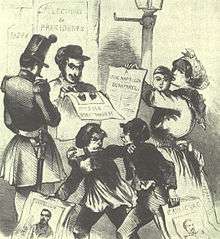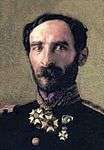French presidential election, 1848
French presidential election, 1848

|
|
|
|
|
|
|
The first-ever French presidential election of 1848 elected the first and only president of the Second Republic. The election was held on 10 December 1848 and led to the surprise victory of Louis-Napoléon Bonaparte with 74% of the vote.
Election
The constitution only included provision for one round, and in the absence of a majority for any candidate, the National Assembly would have decided the victor.[1] Louis-Eugène Cavaignac seemed certain to win, and the Assembly would have most certainly elected him in the absence of an absolute majority.
However, Bonaparte had no long political career behind him and was able to depict himself as "all things to some men". The Monarchist right (supporters of either the Legitimist or Orléanist royal households) and much of the upper class supported him as the "least worst" candidate, as a man who would restore order, end the instability in France which had continued since the overthrow of the monarchy in February, and prevent a proto-communist revolution (in the vein of Friedrich Engels). A good proportion of the industrial working class, on the other hand, were won over by Louis-Napoleon's vague indications of progressive economic views. His overwhelming victory was above all due to the support of the non-politicized rural masses, to whom the name of Bonaparte meant something, as opposed to the other, little-known contenders.[2]
Results

Two boys, one holding a poster for Louis-Napoléon and the other for Cavaignac, fighting
Bonaparte received a plurality or majority in all departments except the Var, Bouches-du-Rhône, Morbihan, and Finistère, all four of which were won by Louis-Eugène Cavaignac. Thus did Bonaparte become the second president in Europe (after Jonas Furrer of Switzerland) and the first French president to be elected by a popular vote.
References


